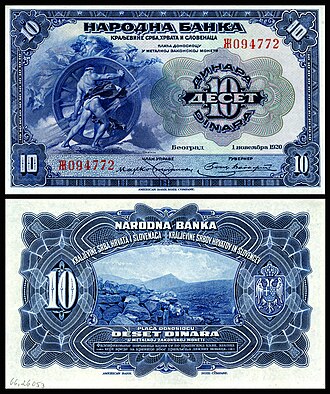The Yugoslav dinar was the currency of the three Yugoslav states: the Kingdom of Yugoslavia, the Socialist Federal Republic of Yugoslavia and the Federal Republic of Yugoslavia (Serbia and Montenegro), between 1918 and 2006. It was subdivided into 100 para. The currency was inaugurated in 1918, with the establishment of the Kingdom of Serbs, Croats and Slovenes, replacing the Serbian dinar. In the early years, it circulated alongside the Yugoslav krone, the successor of the Austro-Hungarian krone. In the early 1990s, the currency was subject to what has been described as the worst hyperinflation in history, as economic mismanagement made the government bankrupt and forced it to take money from the savings of the country's citizens. Inflation rates reached over one billion per cent per year, which led to five revaluations of the currency between 1990 and 1994. In total, there were eight distinct dinari, six of which were given distinguishing names and separate ISO 4217 codes.
This picture shows the obverse (top) and reverse (bottom) sides of a ten-dinara banknote of the Kingdom of Serbs, Croats and Slovenes, dated 1920. It was engraved and printed by the American Bank Note Company. The obverse features an allegory engraved by Robert Savage, entitled "Progress".Banknote credit: American Bank Note Company; imaged by Andrew Shiva
